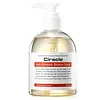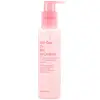What's inside
What's inside
 Key Ingredients
Key Ingredients

 Benefits
Benefits

 Concerns
Concerns

 Ingredients Side-by-side
Ingredients Side-by-side

Water
Skin ConditioningSodium Laureth Sulfate
CleansingGlycerin
HumectantPropylene Glycol
HumectantCocamidopropyl Betaine
CleansingSodium Chloride
MaskingPEG-120 Methyl Glucose Dioleate
EmulsifyingDisodium Laureth Sulfosuccinate
CleansingPhenoxyethanol
PreservativePortulaca Oleracea Extract
Skin ConditioningButylene Glycol
HumectantMelaleuca Alternifolia Leaf Oil
AntioxidantMethylparaben
PreservativeDisodium EDTA
Rhus Semialata Gall Extract
Skin ConditioningSalix Alba Bark Extract
Astringent1,2-Hexanediol
Skin ConditioningSodium Benzoate
MaskingWater, Sodium Laureth Sulfate, Glycerin, Propylene Glycol, Cocamidopropyl Betaine, Sodium Chloride, PEG-120 Methyl Glucose Dioleate, Disodium Laureth Sulfosuccinate, Phenoxyethanol, Portulaca Oleracea Extract, Butylene Glycol, Melaleuca Alternifolia Leaf Oil, Methylparaben, Disodium EDTA, Rhus Semialata Gall Extract, Salix Alba Bark Extract, 1,2-Hexanediol, Sodium Benzoate
Water
Skin ConditioningSodium Lauroyl Sarcosinate
CleansingCocamidopropyl Betaine
CleansingLauramide DEA
Diglycerin
HumectantPEG-120 Methyl Glucose Dioleate
EmulsifyingSodium Chloride
MaskingDisodium Cocoamphodiacetate
CleansingSodium Lauroyl Glutamate
Gluconolactone
Skin ConditioningCapryloyl Salicylic Acid
ExfoliatingButylene Glycol
HumectantHexylene Glycol
EmulsifyingPanthenol
Skin ConditioningMaltodextrin
AbsorbentCitric Acid
BufferingBeta-Glucan
Skin ConditioningSalix Alba Bark Extract
AstringentRosmarinus Officinalis Extract
AntimicrobialLavandula Angustifolia Extract
Skin ConditioningThymus Vulgaris Extract
PerfumingRosa Canina Fruit Extract
AstringentMentha Piperita Extract
CleansingJasminum Officinale Extract
MaskingHibiscus Sabdariffa Flower Extract
Skin ConditioningChamomilla Recutita Extract
Skin ConditioningCalendula Officinalis Extract
Skin ConditioningAspalathus Linearis Extract
Skin ConditioningCyanocobalamin
Skin ConditioningSodium Benzoate
MaskingChlorphenesin
Antimicrobial1,2-Hexanediol
Skin ConditioningWater, Sodium Lauroyl Sarcosinate, Cocamidopropyl Betaine, Lauramide DEA, Diglycerin, PEG-120 Methyl Glucose Dioleate, Sodium Chloride, Disodium Cocoamphodiacetate, Sodium Lauroyl Glutamate, Gluconolactone, Capryloyl Salicylic Acid, Butylene Glycol, Hexylene Glycol, Panthenol, Maltodextrin, Citric Acid, Beta-Glucan, Salix Alba Bark Extract, Rosmarinus Officinalis Extract, Lavandula Angustifolia Extract, Thymus Vulgaris Extract, Rosa Canina Fruit Extract, Mentha Piperita Extract, Jasminum Officinale Extract, Hibiscus Sabdariffa Flower Extract, Chamomilla Recutita Extract, Calendula Officinalis Extract, Aspalathus Linearis Extract, Cyanocobalamin, Sodium Benzoate, Chlorphenesin, 1,2-Hexanediol
 Reviews
Reviews

Ingredients Explained
These ingredients are found in both products.
Ingredients higher up in an ingredient list are typically present in a larger amount.
1,2-Hexanediol is a synthetic liquid and another multi-functional powerhouse.
It is a:
- Humectant, drawing moisture into the skin
- Emollient, helping to soften skin
- Solvent, dispersing and stabilizing formulas
- Preservative booster, enhancing the antimicrobial activity of other preservatives
Butylene Glycol (or BG) is used within cosmetic products for a few different reasons:
Overall, Butylene Glycol is a safe and well-rounded ingredient that works well with other ingredients.
Though this ingredient works well with most skin types, some people with sensitive skin may experience a reaction such as allergic rashes, closed comedones, or itchiness.
Learn more about Butylene GlycolCocamidopropyl Betaine is a fatty acid created by mixing similar compounds in coconut oil and dimethylaminopropylamine, a compound with two amino groups.
This ingredient is a surfactant and cleanser. It helps gather the dirt, pollutants, and other impurities in your skin to be washed away. It also helps thicken a product and make the texture more creamy.
Being created from coconut oil means Cocamidopropyl Betaine is hydrating for the skin.
While Cocamidopropyl Betaine was believed to be an allergen, a study from 2012 disproved this. It found two compounds in unpure Cocamidopropyl Betaine to be the irritants: aminoamide and 3-dimethylaminopropylamine. High-grade and pure Cocamidopropyl Betaine did not induce allergic reactions during this study.
Learn more about Cocamidopropyl BetainePeg-120 Methyl Glucose Dioleate is used to improve texture and stability of a product. It is sugar based and helps thicken a product.
Once applied, it also creates a thin film to trap moisture in. This helps keep your skin hydrated.
This ingredient is the polyethylene glycol ether of the diester of oleic acid and methylglucose. The 120 represents an average of 120 moles of ethylene oxide.
There is limited research on this ingredient, although it is considered safe to use in skincare products.
Learn more about PEG-120 Methyl Glucose DioleateSalix Alba Bark Extract comes from the white willow tree, which is native to Europe and Central Asia.
Salix Alba Bark Extract has often been described as salicylic acid's cousin. This is due to the salicin it contains. However, studies are limited showing salix alba bark to be an effective salicylic acid alternative.
Salicin does have anti-inflammatory and antioxidant properties. It has shown to decrease the formation of inflammatory mediators, such as tumor necrosis factor-α and nuclear factor-kappa B. Salicin also has a mildly exfoliating effect on the skin.
Several other components in salix alba bark extract also contain antioxidant properties, such as flavonoids and polyphenols. Antioxidants may help with anti-aging as they neutralize harmful free-radical molecules.
Willow Bark extract has been used for thousands of years. Ancient civilizations used white willow to help treat pain and fevers.
Learn more about Salix Alba Bark ExtractSodium Benzoate is a preservative. It's used in both cosmetic and food products to inhibit the growth of mold and bacteria. It is typically produced synthetically.
Both the US FDA and EU Health Committee have approved the use of sodium benzoate. In the US, levels of 0.1% (of the total product) are allowed.
Sodium benzoate works as a preservative by inhibiting the growth of bacteria inside of cells. It prevents the cell from fermenting a type of sugar using an enzyme called phosphofructokinase.
It is the salt of benzoic acid. Foods containing sodium benzoate include soda, salad dressings, condiments, fruit juices, wines, and snack foods.
Studies for using ascorbic acid and sodium benzoate in cosmetics are lacking, especially in skincare routines with multiple steps.
We always recommend speaking with a professional, such as a dermatologist, if you have any concerns.
Learn more about Sodium BenzoateChances are, you eat sodium chloride every day. Sodium Chloride is also known as table salt.
This ingredient has many purposes in skincare: thickener, emulsifier, and exfoliator.
You'll most likely find this ingredient in cleansers where it is used to create a gel-like texture. As an emulsifier, it also prevents ingredients from separating.
There is much debate on whether this ingredient is comedogenic. The short answer - comedogenic ratings don't tell the whole story. Learn more about comegodenic ratings here.
The concensus about this ingredient causing acne seems to be divided. Research is needed to understand if this ingredient does cause acne.
Scrubs may use salt as the primary exfoliating ingredient.
Learn more about Sodium ChlorideWater. It's the most common cosmetic ingredient of all. You'll usually see it at the top of ingredient lists, meaning that it makes up the largest part of the product.
So why is it so popular? Water most often acts as a solvent - this means that it helps dissolve other ingredients into the formulation.
You'll also recognize water as that liquid we all need to stay alive. If you see this, drink a glass of water. Stay hydrated!
Learn more about Water